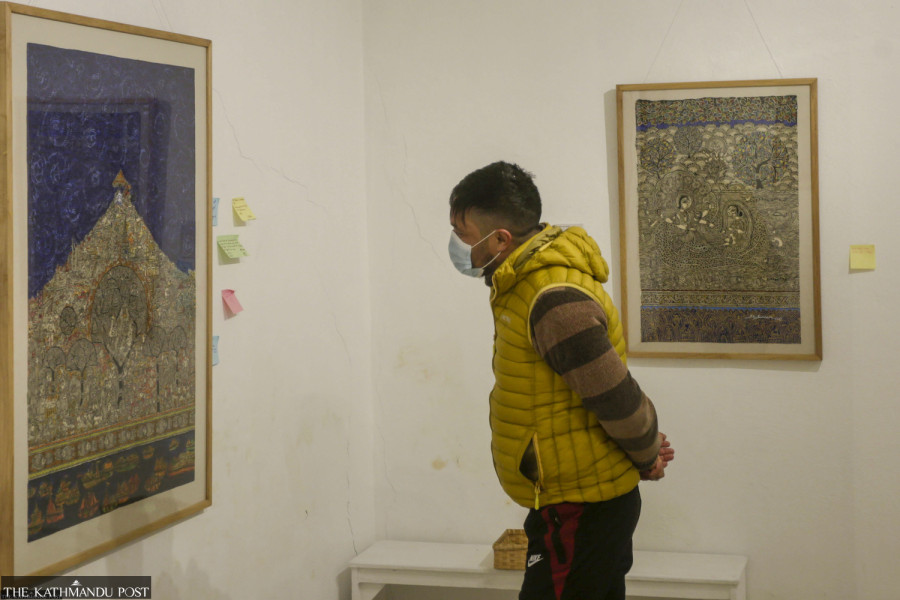Culture & Lifestyle
An interactive Mithila art exhibition
SC Suman’s latest solo exhibition, aptly titled ‘Mithila Cosmos: The Story of Cyclical Time’, fulfils the goal of the artist to fuse contemporary issues with traditional Mithila artwork.
Shranup Tandukar
Mithila art has such a distinctive allure that one can instantly recognise Mithila artwork. The two-dimensional human figures, intricate geometrical designs along with common themes of nature and deities are just some of the eye-catching aspects of Mithila art.
Mithila art initially emerged as an art form dominated by women: Mithila women would use clay, mud, and cow dung to paint the walls of their homes with intricate designs. The establishment of Janakpur Women’s Development Center (JWDC) in 1990 is believed to have marked the transition of Mithila artwork from wall paintings to paper paintings in Nepal. The transition helped commercialise Mithila artwork and helped Tarai women become financially independent.
In current times, the artwork isn’t limited to Mithila women. Subodh Chandra Das, better known as SC Suman from his art signature initials, is one of the frontrunners of Mithila artwork. He was the first person to organise a solo Mithila artwork exhibition in Nepal when he inaugurated ‘Maithili Art Exhibition’ at the All Nepal Medical Conference of Nepal Medical Association in 1991. His latest oeuvre, ‘Mithila Cosmos: The Story of Cyclical Time’, is his 18th solo exhibition and the sixth edition of ‘Mithila Cosmos’ art exhibition series at Siddhartha Art Gallery.
Suman, whose goal has been to “become a link between the long heritage of Mithila art and the contemporary social semiotics of the international art community,” has ventured to portray the story of creation from ancient to contemporary times through the lens of Hindu mythology. There are 32 artworks present in the exhibition, the majority of them being acrylic on Nepali paper (only one artwork titled ‘Kohabar’ is acrylic on art paper).
The first artwork in the exhibition is titled ‘Male female union and creation’ as it deals with the union of shakti (female energy) and shiva (male energy). The artwork is adorned with bright colours typical of Mithila artwork: red, yellow, and black, and they instantly captured my attention. One of the distinct features of Mithila artwork on paper and canvas is the lack of empty spaces: all available space is decorated with relevant geometrical shapes, flowers, patterns, or animals that are symbolic of Mithila culture or Hindu mythology. The abundance of intricate details means that one could spend an entire day ruminating in front of the first painting in the exhibition.
The motifs of creation and destruction are an integral aspect of discussing the cycle of time. While destruction seems like an antithesis to creation, it also allows new creations to appear and continue the cycle. Destruction and creation are two sides of a single coin, and the emergence of one necessitates the emergence of the other. This cyclical theme of creation and destruction is highlighted in the artwork ‘Male female union and creation’ as yoni and lingam fuse together to create life, whereas the theme of destruction is apparent in the artworks ‘Creation and Destruction’ and ‘Devi as a Great Balancer’ as the destructive icons of Kali and Devi are depicted in ‘Creation and Destruction’ and ‘Devi as a Great Balancer.’

In Hindu mythology, a yuga represents the cyclic age of time, which are predestined time periods. As the cyclic age of time progresses from one yuga to another, humanity’s general moral compass progressively degenerates. The cycle of time, the primary theme of the art exhibition, is skillfully depicted in the art exhibition through four artworks titled: ‘Satya Yuga’, ‘Tretā Yuga’, ‘Dvapara Yuga’, and ‘Kali Yuga’, which portray the artist’s visual rendition of the four yugas. Hindu symbolism and iconographies are brimming in every corner of the paintings—gods and asura live together in harmony in ‘Satya Yuga’, Hanuman carries the Dronagiri mountain as Lord Vishnu is reincarnated as Ram in ‘Tretā Yuga’, the tales of Lord Krishna and his mischievous antics in ‘Dvapara Yuga’, the ultimate degeneracy as the powerful destroy the powerless in ‘Kali Yuga’.
Apart from illustrating the tales and lives of Mithila women, Mithila artwork was also a prominent aspect during celebratory occasions such as weddings, sacred rituals, and festivals. The vibrancy of these joyous occasions are captured by Suman and depicted in his artworks, ‘Kohbar Painting’, ‘Ganesh Puja Festival’, ‘Dashami Mela’, ‘Chhath Puja’, and ‘Gauri Puja In The Ramayan’. The ‘Dashami Mela’ is particularly memorable as the artist adroitly uses vivid colours such as red, blue, green, and yellow to depict a festive mood in a Dashain carnival.
The artistic goal of Suman to incorporate contemporary issues through Mithila artwork is reflected in his depiction of the Covid-19 pandemic and its issues through the artworks ‘Scapegoating Bats for the Pandemic’, ‘Covid Lessons’, ‘Lockdown Blues I’, and ‘Lockdown Blues II’. In these artworks, the artist reminds us how humanity’s greed is destroying nature’s ecological balance. Bats, which are quintessential to the ecological balance, are blamed for the pandemic. Trees are felled in countless numbers to make for development projects. In a twist of irony, humans are forced to bring oxygen cylinders in aeroplanes. In a culmination of all our collective greed, the rapid spread of the Covid-19 pandemic resulted in the eerie absence of any humans in buildings, temples, and streets.
Apart from what is actually shown in the artworks, visitors to an art exhibition also derive meaning from how the artworks are presented. In recent times, white cube galleries like the Siddhartha Art Gallery have faced heavy criticism for conferring authority and purity. The pristine, colourless environment of white cube galleries has become a boring cliché. The artworks encased in a glass frame on white background illuminated by overhanging studio lights feel out of reach for the art gallery audience. But in this latest exhibition of SC Suman, the art gallery has attempted to change the boring narrative of a white cube gallery. Colourful sticky notes can be seen adorned near the artworks with feedback from the gallery visitors. In the middle of the ground floor of the art gallery is a bench with sticky notes and sign pens with a note saying ‘INTERACT WITH THE ART’ and ‘PASTE A STICK NOTE NEXT TO YOUR FAVORITE ART PIECE’.
The concept of collecting feedback from visitors is not a novel idea in Siddhartha Art Gallery. A visitor logbook has always been present for visitors to share their impressions of the art exhibitions. A recent entry in the logbook for the current exhibition by Amresh Shah (Janakpur) said, “It’s nice to see my culture in this beautiful representation.” However, the logbook existed more as a formality than as an actual interaction between the artist and visitors.
Now, the walls of Siddhartha Art Gallery with colourful specks of sticky notes create a more welcoming environment than a conventional white cube gallery. “Reminded me of ‘Starry Night’. The Nostalgia” is written on a sticky note near ‘Kali Yuga’ artwork. “Something very gratifying about women in leisure” is written near ‘Women and Water’ artwork. Nevertheless, not all sticky notes are relevant interaction with the art as many sticky notes digress towards other irrelevant themes (“Jimin no got no james” is written on one sticky note).
However, the addition of the sticky notes is an overall positive as artist Suman feels that the addition of sticky notes has allowed him to better understand the impact of his artwork on his audience. “Only people from the older generation prefer to use the logbook to convey their feedback,” says Suman. “However, by introducing the sticky notes this time around, people from the younger generation have also stepped up to provide their feedback.”
The artworks are hypnotisingly captivating as each artwork has intricate details, patterns, and symbols that all have their own meaning and significance. There is a feeling of collective appreciation as one looks at the artwork and reads the accompanying sticky notes. One of them reads-“To inspire someone is a great thing and your art inspires me.” And I couldn’t agree more.
The exhibition will be held until January 15 at Siddhartha Art Gallery, Baber Mahal Revisited.




 12.12°C Kathmandu
12.12°C Kathmandu















